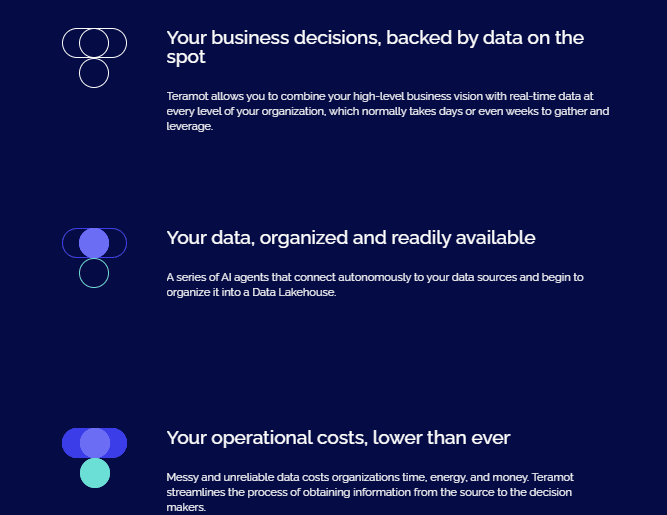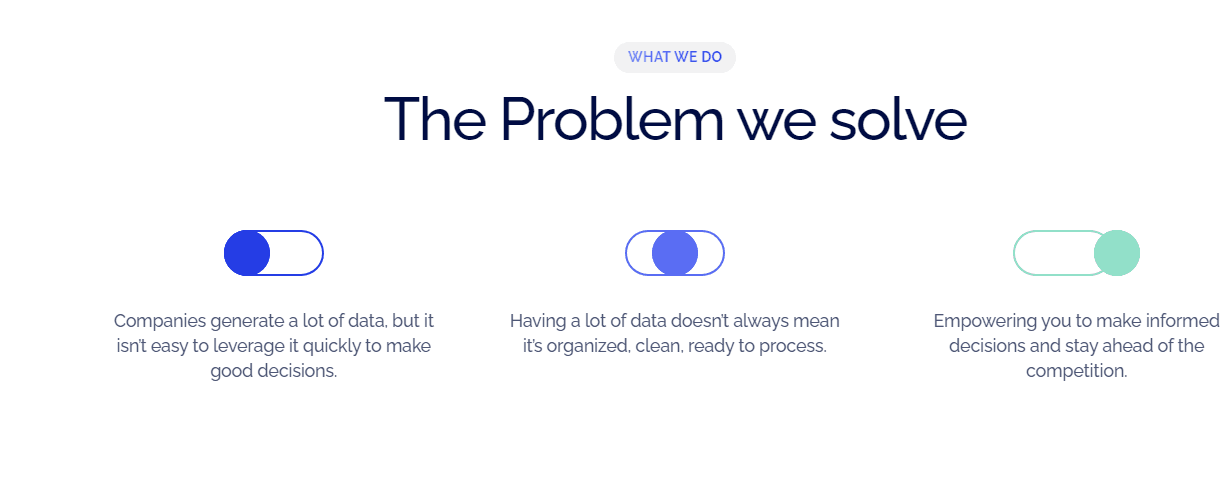Automation and Big Data: Transforming Enterprise Data Management
Is your business struggling with the task of handling massive datasets? It’s a problem many companies face when trying to make sense of big data.
In this article, we’ll discuss how automating big data management can ease the burden of manual processes and boost efficiency.
Without automation, data collection and processing often lead to bottlenecks, slowing down critical decision-making and introducing inaccuracies.
By the end, you'll know how automation not only streamlines data workflows but also helps generate real-time insights, allowing businesses to make informed, timely decisions.
What is Automation in Big Data?
Automation in Big Data refers to the use of advanced technologies and tools to streamline the processes involved in collecting, processing, and analyzing large datasets.
It allows businesses to eliminate manual tasks, reduce errors, and free up valuable human resources for more strategic activities.
By automating repetitive and time-consuming data operations, companies can focus on extracting actionable insights faster and more efficiently.
At its core, Big Data automation revolves around leveraging algorithms, machine learning models, and software tools to handle vast amounts of structured and unstructured data.
These solutions help to organize and optimize data flows without human intervention.
This means that instead of relying on manual intervention for every data update or query, automated systems can manage the data pipeline, ensuring continuous processing, integration, and availability.
Some key functions of automation in Big Data include:
Automated data ingestion from multiple sources
Data transformation and cleansing to prepare it for analysis
Recommended Lecture: Automation and Data Analytics
Common Challenges in Big Data Automation
One major hurdle is the integration of diverse data sources. Many businesses have data residing in various formats and platforms, making it difficult to create a unified system.
Without a cohesive integration strategy, companies may struggle to derive meaningful insights from their data. Common difficulties in this context include:
Diverse Data Formats: Data may originate from multiple sources such as databases, APIs, and flat files, complicating consolidation efforts.
Legacy System Connections: Integrating data from older systems can require significant effort and resources, potentially delaying automation benefits.
Another prevalent challenge is maintaining data quality during the automation process.
As data flows automatically from multiple sources, the risk of inaccuracies increases if not properly validated and cleaned.
This can lead to poor decision-making based on unreliable information. To overcome this, organizations should implement robust data governance policies and quality control measures that accompany automation.
This ensures that data remains accurate and trustworthy throughout all stages of processing.
Finally, organizations may face scalability issues as their data needs grow. As businesses expand, their volume and complexity of data can increase exponentially. Automation systems that perform well with smaller datasets may struggle when confronted with larger or more varied data flows. Considerations for addressing this challenge include:
Choosing the Right Tools: Select automation platforms that are scalable and can grow alongside the business.
Proactive Planning: Design strategies that maintain efficiency and performance as data loads increase.
Recommended Lecture: 10 Benefits of Data Automation
Key Strategies for Implementing Automation in Big Data
One of the key strategies is to start with a clear understanding of business objectives. Organizations should identify specific goals they aim to achieve through automation, such as reducing processing time or enhancing data accuracy.
This clarity helps prioritize automation efforts, ensuring resources are allocated where they will have the most significant impact. To facilitate this process, consider the following steps:
Define Key Performance Indicators (KPIs): Establish measurable outcomes that will indicate success.
Engage Stakeholders: Collaborate with various departments to understand their data needs and challenges.
Another essential strategy is to invest in the right technology that aligns with your data needs. Selecting automation tools that offer flexibility and scalability will allow businesses to adapt to evolving data landscapes.
Organizations should focus on solutions that facilitate seamless integration of different data sources and provide up-to-date insights for quick decision-making. Important aspects to consider when choosing technology include:
Compatibility with Existing Systems: Ensure new tools can integrate smoothly with current data infrastructure.
User-Friendly Interfaces: Opt for solutions that empower teams to leverage automation without extensive technical expertise.
Finally, it’s crucial to foster a culture of continuous improvement. Automation in big data is not a one-time effort; it requires ongoing evaluation and refinement.
Regularly assess the performance of automated processes and be open to feedback from users. This iterative approach helps organizations identify areas for enhancement and ensures that automated workflows remain effective over time. Key practices include:
Conducting Regular Audits: Review automation processes to pinpoint inefficiencies.
Encouraging Innovation: Create an environment where team members feel empowered to suggest improvements and new ideas.
How Do You Identify Data Automation Opportunities?
Identifying data automation opportunities requires a systematic approach that starts with a clear understanding of your business processes and data workflows.
Begin by analyzing the current data management practices to pinpoint areas where automation can enhance efficiency. This involves evaluating repetitive tasks, data entry processes, and reporting mechanisms.
By focusing on these elements, you can uncover opportunities that not only save time but also reduce human error.
Key areas to consider when looking for automation opportunities include:
Repetitive Tasks: Identify tasks that require significant manual input and can be automated, such as data collection and processing.
Data Integration: Assess how data from various sources is merged and identify points where automation can streamline this integration.
Reporting Needs: Examine the reporting processes and determine if automation can deliver insights that are up-to-date, facilitating quicker decision-making.
After identifying potential areas for automation, it's essential to involve stakeholders from various departments.
Their insights can provide valuable context about the data processes and the impact of automation on their workflows.
Gather feedback and assess the feasibility of automation initiatives based on resource availability and expected return on investment.
By systematically identifying data automation opportunities, organizations can set the foundation for a more efficient, agile, and flexible data management strategy.
Recommended Lecture: Data Automation Services
How Do You Develop Scalable Automated Workflows?
Creating scalable automated workflows is crucial for organizations looking to boost efficiency and adapt quickly to changing data needs.
Start by examining your existing processes. This means understanding how tasks are currently performed, who is involved, and which tools are being used.
By mapping out each step, you can spot areas that may benefit from automation, helping streamline your operations.
Next, focus on designing workflows that can grow with your business. Consider these practical strategies:
Modularity: Break down workflows into smaller, manageable components. This way, you can enhance specific parts without needing to redesign everything.
Cloud Solutions: Leverage cloud-based tools that offer flexibility and can scale to handle varying workloads, allowing you to avoid heavy investments in infrastructure.
Automate Repetitive Tasks: Identify tasks that consume a lot of time but are repetitive. Automating these can free up your team to focus on more valuable work.
Lastly, set up monitoring and feedback systems. After implementing your automated workflows, keep an eye on how they perform.
Gather input from team members who use these processes regularly; their feedback can highlight any challenges or areas for improvement.
By continuously refining your workflows based on real insights, you can ensure they remain efficient and effective as your organization evolves.

How Do You Monitor and Optimize Automated Data Processes?
The first step is establishing key performance indicators (KPIs). These metrics will help you gauge the efficiency and effectiveness of your automated workflows. Consider tracking aspects like:
Processing Time: Measure how long it takes for data to flow through your automated systems.
Error Rates: Monitor the frequency of issues or failures in the data processing.
Data Quality: Evaluate the accuracy and reliability of the information produced.
Once you have your KPIs in place, utilize monitoring tools to gain real-time visibility into your data processes.
These tools can provide insights into how your workflows perform, allowing you to spot trends and identify potential issues early.
Regularly reviewing these metrics helps you stay proactive rather than reactive, enabling you to address concerns before they escalate. Some useful monitoring techniques include:
Dashboards: Visualize data trends and performance metrics in an easily digestible format.
Alerts: Set up notifications for anomalies or performance drops to take immediate action.
Regular Audits: Conduct periodic assessments of your processes to ensure they align with your goals.
Finally, optimize your automated processes based on the data collected. This means not only addressing any immediate problems but also seeking opportunities for continuous improvement.
Engage your team in this process, as their firsthand experiences can offer valuable perspectives on what changes might lead to better outcomes.
By fostering a culture of ongoing optimization, you can ensure your automated data processes remain efficient and aligned with your organization's goals. Key steps in the optimization process might include:
Identifying Bottlenecks: Analyze workflow performance to find areas that slow down processes.
Enhancing Automation: Look for repetitive tasks that can be automated further.
Training Staff: Equip your team with the skills needed to manage and improve automated processes.
How Automation and Big Data Improve Business Outcomes
Automation and big data are powerful allies in driving business success, enabling organizations to make informed decisions swiftly and effectively. By harnessing the potential of big data, businesses can uncover patterns and trends that would otherwise remain hidden.
This wealth of information, combined with automation, leads to enhanced decision-making capabilities. When data is automatically collected and analyzed, decision-makers can focus on strategic initiatives rather than getting bogged down by mundane tasks.
Moreover, automation significantly boosts operational efficiency. By streamlining data processes, organizations can reduce the time and resources spent on repetitive tasks. This efficiency not only lowers operational costs but also frees up valuable human resources to engage in higher-level work. Key benefits include:
Faster Turnaround Times: Automated processes lead to quicker data retrieval and analysis.
Reduced Errors: Automation minimizes human intervention, thus decreasing the likelihood of mistakes.
Consistent Quality: Automated workflows ensure that data is processed uniformly, leading to higher quality outcomes.
Additionally, the integration of big data analytics into automated systems can enhance customer experiences.
By analyzing customer behavior and preferences, businesses can tailor their offerings to meet specific needs.
This level of personalization fosters customer loyalty and satisfaction, ultimately driving sales and revenue growth. Some specific advantages include:
Targeted Marketing: Utilize insights from big data to develop personalized marketing strategies.
Improved Product Development: Analyze customer feedback to refine existing products or create new ones that meet market demands.
Proactive Customer Service: Use data insights to anticipate customer needs and address issues before they escalate.
In summary, the synergy between automation and big data equips businesses with the tools necessary to navigate today's fast-paced environment effectively. This combination not only optimizes internal processes but also enhances the overall customer experience, creating a strong foundation for sustainable growth.
How Automation and Big Data Improve Business Outcomes
Automation and big data work hand in hand to enhance business outcomes by providing organizations with the insights and efficiency needed to thrive.
When you combine automated data processing with big data analytics, you can uncover trends and insights that drive informed decision-making.
This means less time spent on manual data handling and more focus on strategic initiatives that push the business forward.
One of the most significant advantages of automation in the realm of big data is the boost in operational efficiency.
By automating data collection and analysis, businesses can cut down on time and resources spent on repetitive tasks. This efficiency leads to:
Faster Data Access: Automated systems provide quick access to data, which is essential for timely decision-making.
Lower Error Rates: Automation reduces human error, ensuring that data processing is more accurate.
Resource Allocation: With routine tasks automated, team members can focus on higher-level, value-added activities.
Moreover, leveraging big data through automation allows for a more personalized customer experience. By analyzing customer behavior, businesses can tailor their services and products to meet specific needs, leading to increased satisfaction and loyalty. This results in:
Targeted Marketing Efforts: Insights derived from data help create more effective marketing campaigns.
Informed Product Development: Understanding customer feedback enables businesses to improve existing products and develop new ones.
Proactive Customer Support: Anticipating customer needs can lead to better service and retention rates.
In essence, the partnership between automation and big data is vital for companies looking to adapt and thrive in a competitive landscape.
By harnessing these technologies, businesses can streamline processes, enhance decision-making, and ultimately drive growth.
Company Offering Data Science and Big Data Automation Solution
At Teramot, we understand that the landscape of data management is evolving rapidly, and businesses need solutions that can adapt just as quickly.
Our approach is built around flexibility and agility, ensuring that our clients can navigate their data challenges effectively.
We pride ourselves on creating privacy-conscious solutions, allowing companies to harness the power of their data without compromising security.
What Teramot Offers:
Flexibility: Our solutions are designed to grow with your business, adjusting to your specific needs and scale.
Agility: Quick integration of different data sources helps streamline operations, making data workflows seamless.
Up-to-date insights: Instead of relying on outdated reports, we provide insights that reflect the latest data trends, enabling informed decision-making.
Increased efficiency: Automation drives productivity, allowing teams to focus on strategic initiatives rather than repetitive tasks.

We believe that effective data management isn't just about technology; it's about building relationships and understanding the unique challenges our clients face.
Teramot is available globally, offering its expertise and advanced technology to transform how you manage and leverage your data.
Book a demo with us today and experience how our solutions can streamline your processes and enhance your decision-making capabilities.

FAQs: Automation and Big Data
What is automation in big data?
Automation in big data refers to using software tools and algorithms to streamline data collection, processing, and analysis, reducing manual efforts and errors. It enables businesses to manage vast amounts of data efficiently, ultimately enhancing decision-making and operational efficiency.
What is the connection between RPA and big data?
Robotic Process Automation (RPA) complements big data by automating repetitive tasks such as data entry and extraction, allowing organizations to focus on analyzing large datasets rather than managing them manually.
Can AI handle big data?
Yes, AI technologies excel in handling big data by analyzing vast datasets to identify patterns and trends, driving insights and predictions. According to a McKinsey report, organizations using AI can enhance their productivity by 40% or more.
How is automation related to data science?
Automation streamlines data preparation and analysis, enabling data scientists to focus on model development and insights. Research indicates that automating data processing can reduce analysis time by up to 70%, enhancing productivity and innovation in data science projects.


